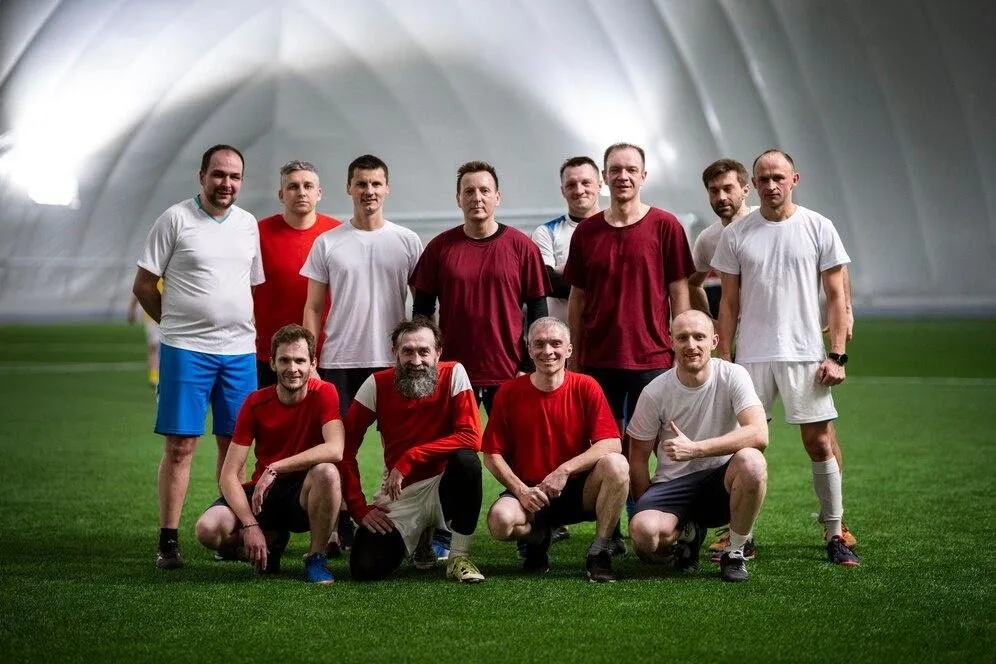Similitudes Entre Equipos de Trabajo y Equipos de Futbol
[Versión En Español]
Me encanta el fútbol, es el deporte que más me apasiona y el que no solamente veo, también trato de analizar desde un punto de vista lógico y estratégico. Como muchos comprenderán, el fútbol va más allá de un puñado de sujetos corriendo detrás de un balón. Este deporte contiene una serie de estrategias y tácticas que se amoldan al equipo y que suben las probabilidades de éxito, todo esto sucede en el campo de juegos de una manera tan sutil que pasa desapercibida toda esa estrategia que envuelve a un equipo de alto rendimiento.

Creando el Equipo
El principal aspecto determinante es la creación del equipo, en el caso del futbol son 11 jugadores, sin embargo, el equipo para un proyecto puede ser mayor o menor dependiendo de la envergadura, sin embargo, la construcción del equipo se basa en la misma estrategia que en el futbol.
Jugadores Principales
Los equipos de trabajo y de fútbol se construyen dependiendo de las habilidades y las características de cada jugador o miembro del equipo. En el fútbol hay muchas posiciones, desde el guardameta hasta el delantero. Cada posición del campo requiere características distintas del jugador; esa es la razón por la cual muchos jugadores no juegan al mismo nivel si juegan en una posición distinta a la que acostumbran.

Entrenador/Director
El entrenador es la figura más importante, puede ser un gerente o un director, este diseña un plan de trabajo dependiendo de los objetivos y basado en ese planteamiento construye al equipo, sin embargo, hay dos maneras de construir este equipo.
Estrategia para el Equipo o Equipo para la Estrategia
En las organizaciones, es común diseñar un plan de negocios y luego pasar a la construcción del equipo basado en los objetivos de la planificación, en ese caso la organización debe contratar a los miembros del equipo para la gestión de todos los procesos, sin embargo, posiblemente la organización no sea capaz de contratar más personal y simplemente debe utilizar los individuos disponibles en nómina, lo que significa que la estrategia cambia en función al equipo que se construye, aunque los objetivos sigue siendo la victoria.
El entrenador debe conocer bien el recurso humano que posee, conocer sus habilidades, características, tanto sus puntos fuertes como sus debilidades, de acuerdo a las capacidades se le elige una labor en el equipo, que se complemente con el resto.

En el futbol existe jugadores en el medio campo que hacen que el balón haga la transición desde la defensa hasta el ataque, aunque este mediocampista no anote el gol, su labor es indispensable para la victoria del equipo, así como cuando un vendedor cierra un trato bajo una estrategia de marketing y presentaciones creadas por un diseñador gráfico, aspectos que vienen desde el equipo, el vendedor solamente no podría concretar la venta sin las herramientas dadas por su equipo.
Liderazgo
el entrenador o director, debe tener el liderazgo suficiente para tomar las decisiones correctas en cuanto al equipo, disminuir los conflictos internos y colocar a los miembros del equipo en los lugares que realmente sean efectivos, además, debe crear un sistema en que el trabajo pueda engranarse de manera eficiente.
El director debe conocer los límites físicos y mentales de su equipo, sabemos que en el futbol hay sobrecargas musculares, sin embargo, en un equipo de trabajo también puede existir cansancio mental, el entrenador debe tener las estrategias correctas para que la mentalidad de sus miembros del equipo jueguen a su favor.
Tácticas y Estrategias
Antes de cualquier partido de futbol, los jugadores ya conocen su lugar en el campo, pero también conocen su función, es decir, ellos conocen lo que deben hacer al momento de atacar y defender, además de la manera en que las probabilidades juegan a su favor, así mismo ocurre en el equipo de trabajo.
Los equipos no solo deben construirse según sus capacidades, también debe existir un sistema interno que permita que los proceso sean más eficientes, ese engranaje en el equipo es tan importante como los miembros que componen el equipo, después de todo, se puede tener al mejor talento del mundo en el equipo, pero si no conoce su función, es lo mismo que nada.
Motivación
Desde mi punto de vista, la motivación compone uno de esos aspectos vitales que muchas veces se deja de lado, pensamos que la motivación siempre puede estar en el aspecto económico, pero realmente va mucho más allá que eso, los equipos de alto rendimiento tienen motivaciones, los jugadores en un mundial de futbol tienen la motivación de representar todo un país, los jugadores desean llegar al mejor club y ganar muchos títulos. La motivación en el equipo de trabajo puede influir directamente en el éxito o en el fracaso del equipo.

Feedback
El equipo debe estar consciente en las fortalezas y los puntos de mejora, el entrenador debe cambiar las piezas, tácticas o estrategias cuando sea necesario para cumplir los objetivos. Los equipos deben reunirse para analizar los números y siempre proponer una mejora continua en los procesos. Ese análisis que puede significar una reunión corta de algunos minutos, puede ser vital para el cumplimiento de los objetivos.
Gracias por tu lectura, hasta la próxima

Similarities Between Work Teams and Football Teams
[English Version]
I love football, it is the sport I am most passionate about and the one I not only watch, but also try to analyse from a logical and strategic point of view. As many will understand, football is more than just a bunch of guys running after a ball. The sport contains a series of strategies and tactics that are moulded to the team and that increase the chances of success, all of which happen on the pitch in such a subtle way that the strategy that surrounds a high-performance team goes unnoticed.

Creating the Team
The main determining aspect is the creation of the team, in the case of football there are 11 players, however, the team for a project can be bigger or smaller depending on the size, however, the construction of the team is based on the same strategy as in football.
Key players
Work teams and football teams are built depending on the skills and characteristics of each player or team member. In football there are many positions, from goalkeeper to striker. Each position on the field requires different characteristics from the player; that is why many players do not play at the same level if they play in a different position than they are used to.

Coach/Manager
The coach is the most important figure, he/she can be a manager or a director, he/she designs a work plan depending on the objectives and based on that approach builds the team, however, there are two ways to build this team.
Strategy for the Team or Team for the Strategy
In organisations, it is common to design a business plan and then move on to building the team based on the objectives of the planning, in that case the organisation must hire team members to manage all the processes, however, the organisation may not be able to hire more staff and must simply use the individuals available on the payroll, which means that the strategy changes depending on the team that is built, although the objectives remains the win.
The coach must know well the human resources he has, know their skills, characteristics, strengths and weaknesses, and according to their capabilities, choose a job in the team that complements the rest of the team.

In football there are players in the midfield who make the ball transition from defence to attack, even if this midfielder does not score the goal, his work is indispensable for the team's victory, just as when a salesman closes a deal under a marketing strategy and presentations created by a graphic designer, aspects that come from the team, the salesman alone could not make the sale without the tools given by his team.
Leadership
The coach or manager must have enough leadership to make the right decisions regarding the team, to reduce internal conflicts and to place the team members in the places where they are really effective and to create a system in which the work can mesh in an efficient way.
The manager must know the physical and mental limits of his team, we know that in football there are muscular overloads, however, in a working team there can also be mental fatigue, the coach must have the right strategies so that the mentality of his team members play in his favour.
Tactics and Strategies
Before any football match, the players already know their place on the pitch, but they also know their function, i.e. they know what they have to do when attacking and defending, as well as the way in which the odds play in their favour, the same is true for the team.
Teams should not only be built according to their capabilities, there must also be an internal system that allows the process to be more efficient, that gear in the team is as important as the members that make up the team, after all, you can have the best talent in the world in the team, but if they do not know their role, it is the same as nothing.
Motivation
From my point of view, the motivation is one of those vital aspects that many times is left aside, we think that the motivation can always be in the economic aspect, but really it goes much further than that, the high performance teams have motivations, the players in a football world cup have the motivation to represent a whole country, the players want to get to the best club and win many titles. Motivation in the team can directly influence the success or failure of the team.

Feedback
The team should be aware of strengths and areas for improvement, the coach should change pieces, tactics or strategies when necessary to meet objectives. Teams should meet to analyse the numbers and always propose continuous improvement in processes. That analysis, which can mean a short meeting of a few minutes, can be vital to the achievement of objectives.

Translated with DeepL.com (free version)
